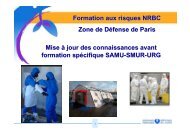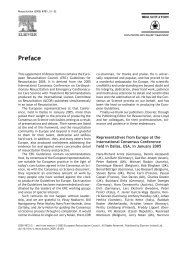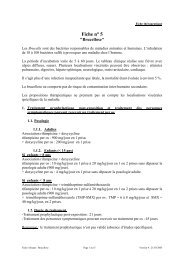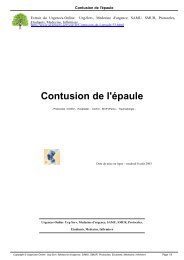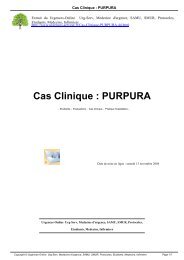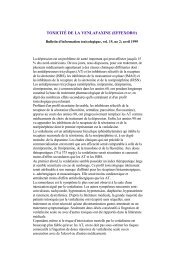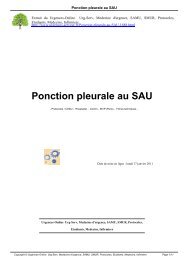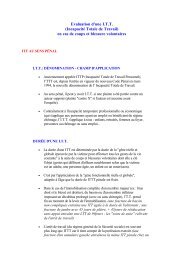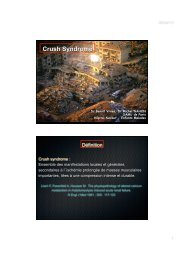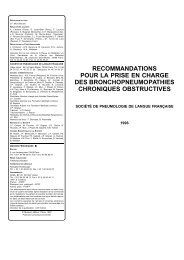avion sanitaire, avion de ligne
avion sanitaire, avion de ligne
avion sanitaire, avion de ligne
You also want an ePaper? Increase the reach of your titles
YUMPU automatically turns print PDFs into web optimized ePapers that Google loves.
EVACUATION<br />
ET<br />
RAPATRIEMENT<br />
SANITAIRE AERIEN<br />
Dr Hervé Raffin<br />
SAMU <strong>de</strong> Paris / Medic’Air International<br />
herve.raffin@medic-air.eu
Différents types <strong>de</strong> Missions<br />
Aériennes<br />
Sauvetage : Search and Rescue (crash d’<strong>avion</strong>),<br />
secours en mer, en montagne … moyens<br />
secouristes<br />
Primaire : Hélicoptère SAMU, Service <strong>de</strong> Santé<br />
<strong>de</strong>s Armées, Prise en charge « sur site » en<br />
Afrique (Medic’Air)<br />
Secondaire : transfert inter hospitalier SAMU<br />
(hélicoptère – <strong>avion</strong>), compagnies d’assistance<br />
(<strong>avion</strong> <strong>sanitaire</strong>, <strong>avion</strong> <strong>de</strong> <strong>ligne</strong>)<br />
Tertiaire : retour à domicile en <strong>avion</strong> <strong>de</strong> <strong>ligne</strong> :<br />
services sociaux, compagnies d’assistance…
Service Public : SAMU<br />
Régulation par SAMU : Bilan médical,<br />
adéquation du transport et <strong>de</strong>s moyens<br />
Moyens SAMU:<br />
Hélicoptère Blanc SAMU, Rouge Sécurité<br />
Civile, Bleu Gendarmerie<br />
Avion : King 90 SAMU Corse, affrètement<br />
Missions : Primaire et Secondaire
Privé : Compagnies d’Assistance<br />
Assureurs (Fr.), Automobiles Clubs (Eu), Compagnie<br />
aérienne (Rega), Société <strong>de</strong> services (Medic’Air)<br />
Régulation <strong>de</strong>s rapatriements :<br />
Estimation et contrôle <strong>de</strong>s risques<br />
Rôle du mé<strong>de</strong>cin / bilans médicaux<br />
Critères restrictifs suivant les cas<br />
exclusions / contrat assurance,<br />
évacuation <strong>de</strong> proximité…
Assistance (suite)<br />
Objectifs<br />
Amélioration du pronostic : évacuation<br />
Confort du patient : rapatriement<br />
Moyens :<br />
Avion <strong>sanitaire</strong>, <strong>avion</strong> affrété<br />
Avion <strong>de</strong> <strong>ligne</strong><br />
Combi Evac…
1 / Helicoptère
Hélicoptère : Limites 1<br />
Rayon d’action limité<br />
Restriction météo<br />
Accessibilité limitée<br />
au patient :<br />
Patient calme ou sédaté<br />
Sous monitoring<br />
Anticipation <strong>de</strong>s gestes<br />
(Intubation)<br />
Drogues prêtes à injection
Hélicoptère : Limites 2<br />
Ambiance hostile :<br />
bruit, turbulences<br />
Vibrations<br />
Majoration <strong>de</strong>s<br />
hémorragies<br />
Rotation <strong>de</strong>s pâles<br />
Epileptogène
Hélicoptère 3<br />
Nouvelle Génération<br />
Bi turbine<br />
Chargement arrière<br />
Accès à la tête du patient<br />
1 à 2 civières<br />
bruit diminué<br />
Explorer, EC 135 …
AVION : ASAN et Avion <strong>de</strong> <strong>ligne</strong>
Avion : Contraintes physiques<br />
Variation <strong>de</strong> pression cabine<br />
Baisse <strong>de</strong> pression partielle<br />
d’oxygène<br />
Air sec, oxygène médical sec<br />
Froid<br />
Accélération take-off, Décélération<br />
poser<br />
Place limitée<br />
Ventilation cabine par Air recyclé
Loi <strong>de</strong> Dalton<br />
Pression partielle <strong>de</strong>s gaz :<br />
P T = x a .P a + x b .P b + x c .P c<br />
PO 2 = x.O 2 x P T<br />
= 0,21 x P<br />
= 0,21 x PT
Application <strong>de</strong> la loi <strong>de</strong> Dalton<br />
Niveau <strong>de</strong> la mer<br />
P T 760 mm Hg => PO 2<br />
160 mm Hg<br />
Niveau 60 / 1800 m<br />
PT 609 mm Hg => PO2 128 mm Hg<br />
Si FiO2 passe <strong>de</strong> 21% à 27%<br />
Niveau 80 / 2400 m<br />
P T 565 mm Hg => PO 2<br />
=> PO 2 164 mm Hg<br />
118 mm Hg
Loi d’expansion <strong>de</strong>s gaz<br />
Loi <strong>de</strong> Mariotte :<br />
P x V = n x R x T = cste<br />
Température estimée constante au sol,<br />
En montée, perte moyenne <strong>de</strong> 2°C par 300m<br />
Avion <strong>de</strong> <strong>ligne</strong>,<br />
altitu<strong>de</strong> <strong>de</strong> croisière 10 000m<br />
-> Pressurisation : 1 800m à 2 400m
Application Loi <strong>de</strong> Mariotte<br />
Cavités naturelles<br />
ouvertes<br />
Cavités semiouvertes<br />
: carie,<br />
sinusite…<br />
Cavités fermées :<br />
Pneumothorax<br />
Occlusion intestinale<br />
Trauma. Pénétrants<br />
Communication<br />
naturelle<br />
Douleur, perte<br />
fonctionnelle<br />
Drainage<br />
(Aspiration)<br />
Altitu<strong>de</strong> zéro / sea<br />
level
Cas particuliers<br />
Acci<strong>de</strong>nt <strong>de</strong> décompression :<br />
Plongée sous marine, tunnelier<br />
Traitement par caisson hyperbare<br />
Chirurgie par coelioscopie :<br />
Résorption du gaz (Hélium) avant<br />
rapatriement en <strong>avion</strong>
Contraintes<br />
Avion <strong>de</strong> <strong>ligne</strong><br />
Manque <strong>de</strong> flexibilité, fonction <strong>de</strong>s<br />
places disponibles, autorisations<br />
indispensables<br />
Respect <strong>de</strong>s autres passagers, aspects<br />
commerciaux<br />
Espace limité : civière ou extra-seat<br />
Limitation en oxygène, restriction<br />
électrique
Extra –seat Frontal et Civière
Avion <strong>de</strong> <strong>ligne</strong> : accès et place
Patiente intubée, ventilée, sédatée<br />
sur Civière / Air France
Gran<strong>de</strong> souplesse :<br />
horaire, routes,<br />
pression cabine…<br />
Pas <strong>de</strong> contrainte<br />
commerciale<br />
Espace limité<br />
Contrôle<br />
contagiosité<br />
Emport <strong>de</strong> matériel<br />
plus important<br />
Avion <strong>sanitaire</strong>
Gestion <strong>de</strong> l’espace et du matériel<br />
Sortie <strong>de</strong> bloc neurochirurgical / Falcon 10 / Skopje Guerre du Kosovo
Chargement à bord d’un Falcon 50
Chargement Civière Beech 1900<br />
Porte Cargo et rampe
CPIA sur choc cardiogénique
Beech King Air 1900C « Pelican »<br />
www.medic-air.com
Matériel <strong>de</strong> base à bord<br />
Monitoring : Sat O2, ECG, TA, Pouls…<br />
artère, Et CO2,<br />
Matériel <strong>de</strong> réanimation (intubation,<br />
drainage, drogues …) et <strong>de</strong> nursing<br />
Aspirateur <strong>de</strong> mucosités,<br />
Ventilateur + Oxygène aéronautique,<br />
Défibrillateur (norme aéronautique),<br />
Dispositif <strong>de</strong> perfusion continue (pousse<br />
seringue, pompe à galet),<br />
Matelas coquille, civière/sangles.
Combi Evac<br />
Évacuation primaire sur longues distances<br />
Hélico local<br />
relais à<br />
Port-Harcourt<br />
Nigeria<br />
Arret Cardiaque<br />
40ans<br />
sera intubé<br />
sur le tarmac<br />
avant d’embarquer<br />
dans le Falcon 50
Rapatriement Sanitaire Aérien<br />
Qualité <strong>de</strong> l’équipe médicale<br />
Qualité du matériel <strong>de</strong> soins et monitorage<br />
Logistique performante<br />
Mise en condition du patient avant<br />
l’embarquement, anticipation <strong>de</strong>s gestes<br />
Gestion <strong>de</strong> l’environnement<br />
Autonomie : flui<strong>de</strong>s et électricité<br />
Maîtrise <strong>de</strong>s lois physiques <strong>de</strong>s gaz
Conclusion : Contrôle <strong>de</strong>s risques<br />
à chaque étape<br />
Importance <strong>de</strong> l’équipe médicale <strong>de</strong> Régulation<br />
Nombreux paramètres à contrôler :<br />
Médical / Aérien / Logistique / Financier / Politique



